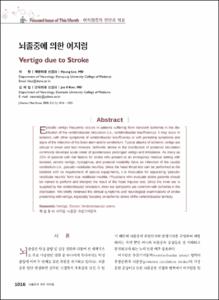뇌졸중에 의한 어지럼
- Keimyung Author(s)
- Lee, Hyung
- Department
- Dept. of Neurology (신경과학)
- Journal Title
- Journal of the Korean Medical Association
- Issued Date
- 2008
- Volume
- 51
- Issue
- 11
- Keyword
- Vertigo; Stroke; Vertebrobasilar artery
- Abstract
- Episodic vertigo frequently occurs in patients suffering from transient ischemia in the distribution of the vertebrobasilar circulation (i.e., vertebrobasilar insufficiency). It may occur in isolation, with other symptoms of vertebrobasilar insufficiency or with persisting symptoms and signs of the infarction of the brain stem and/or cerebellum. Typical attacks of ischemic vertigo are abrupt in onset and last minutes. Ischemic stroke in the distribution of posterior circulation commonly develops acute onset of spontaneous prolonged vertigo and imbalance. As many as 25% of patients with risk factors for stroke who present to an emergency medical setting with isolated, severe vertigo, nystagmus, and postural instability have an infarction of the caudal cerebellum (i.e., pseudo-vestibular neuritis). Since the head thrust test can be performed at the bedside with no requirement of special equipments, it is invaluable for separating 'pseudo-vestibular neuritis' from true vestibular neuritis. Physicians who evaluate stroke patients should be trained to perform and interpret the result of the head impulse test. Since the inner ear is supplied by the vertebrobasilar circulation, inner ear symptoms are common with ischemia in the distribution. We briefly reviewed the clinical symptoms and neurological examinations of stroke presenting with vertigo, especially focusing on ischemic stroke of the vertebrobasilar territory.
- Alternative Title
- Vertigo due to Stroke
- Keimyung Author(s)(Kor)
- 이형
- Publisher
- School of Medicine
- Citation
- 이형 and 김재일. (2008). 뇌졸중에 의한 어지럼. Journal of the Korean Medical Association, 51(11), 1016–1024. doi: 10.5124/jkma.2008.51.11.1016
- Type
- Article
- ISSN
- 1975-8456
- Appears in Collections:
- 1. School of Medicine (의과대학) > Dept. of Neurology (신경과학)
- 파일 목록
-
-
Download
 oak-aaa-3181.pdf
기타 데이터 / 525.88 kB / Adobe PDF
oak-aaa-3181.pdf
기타 데이터 / 525.88 kB / Adobe PDF
-
Items in Repository are protected by copyright, with all rights reserved, unless otherwise indicated.